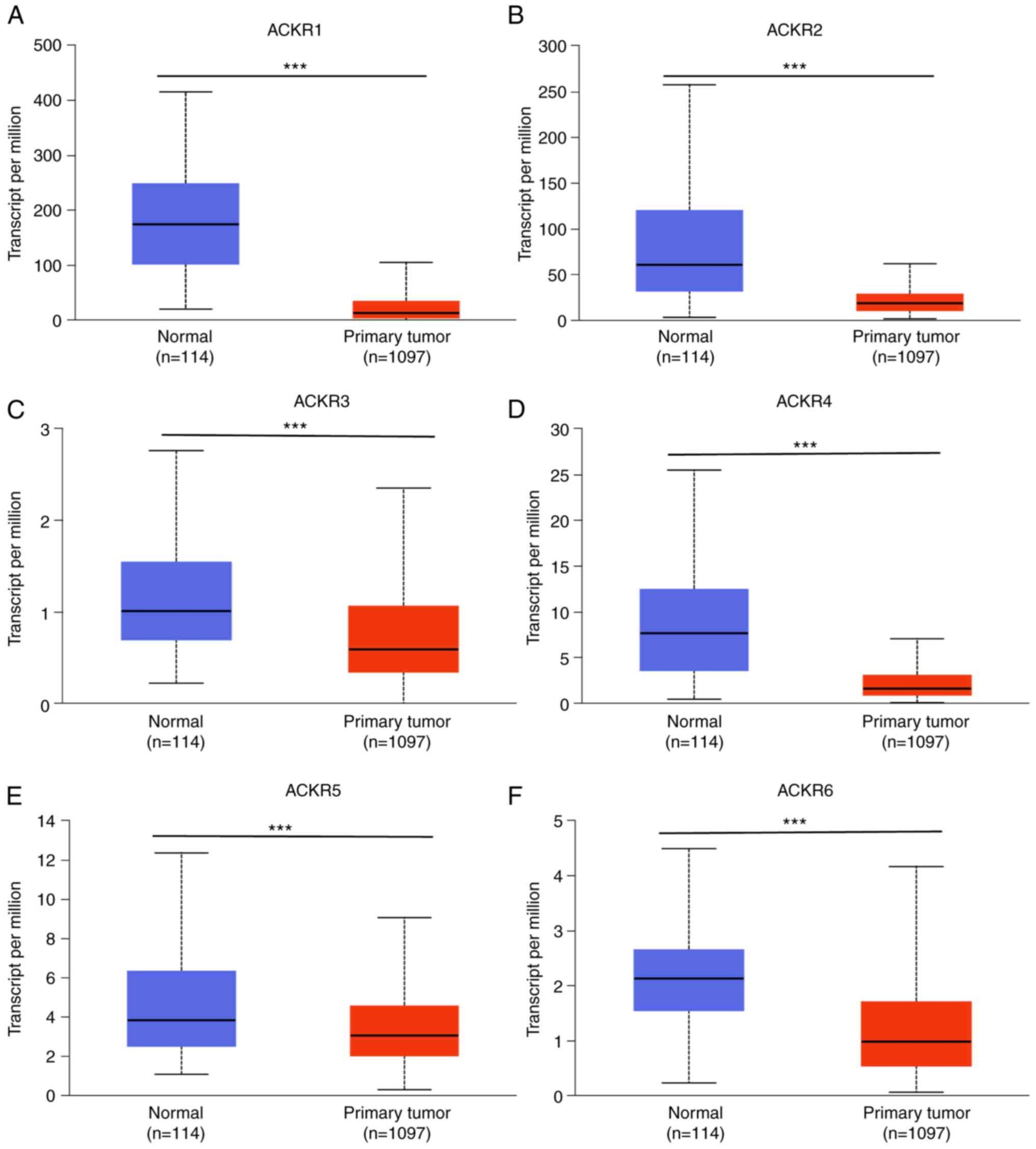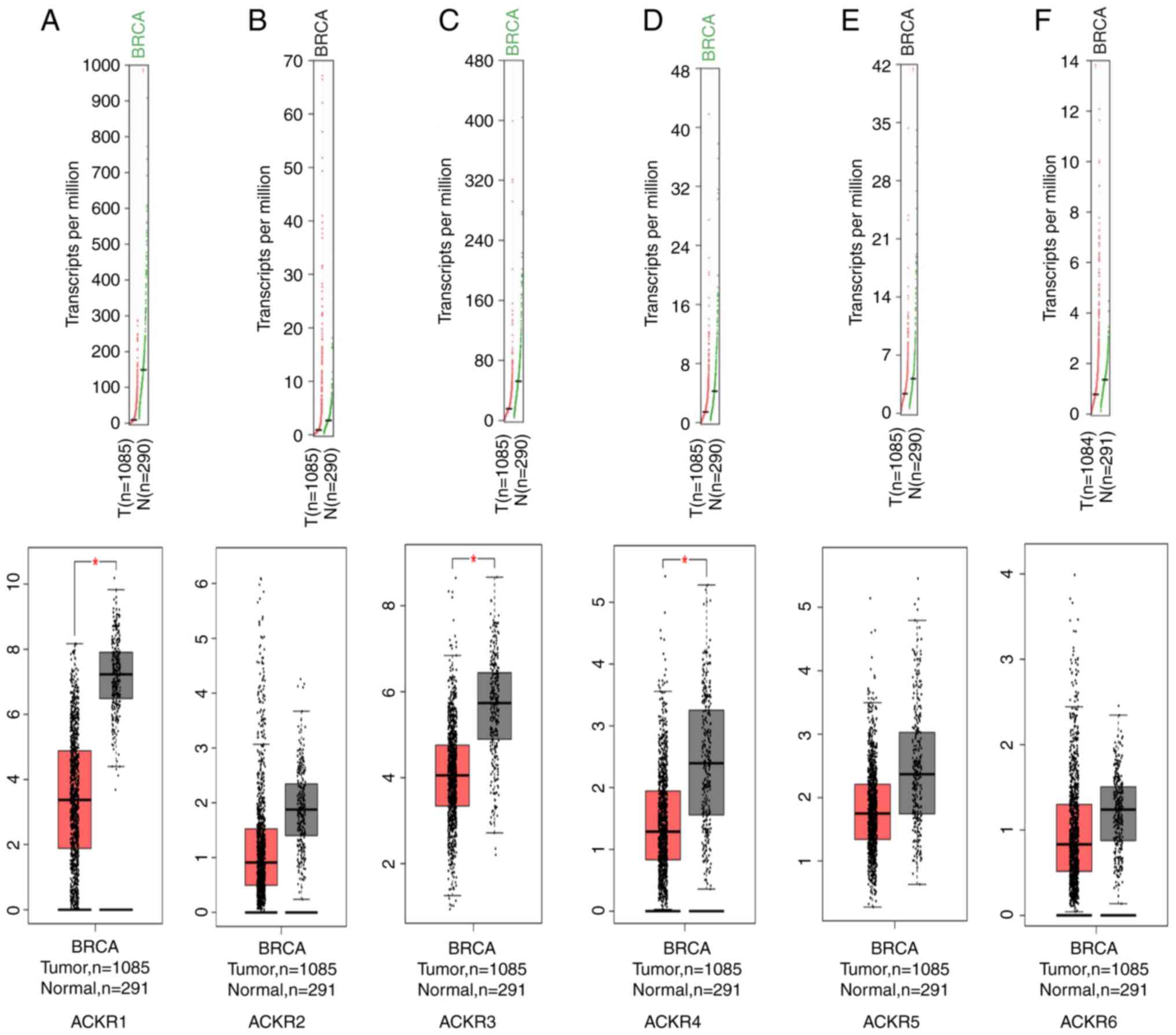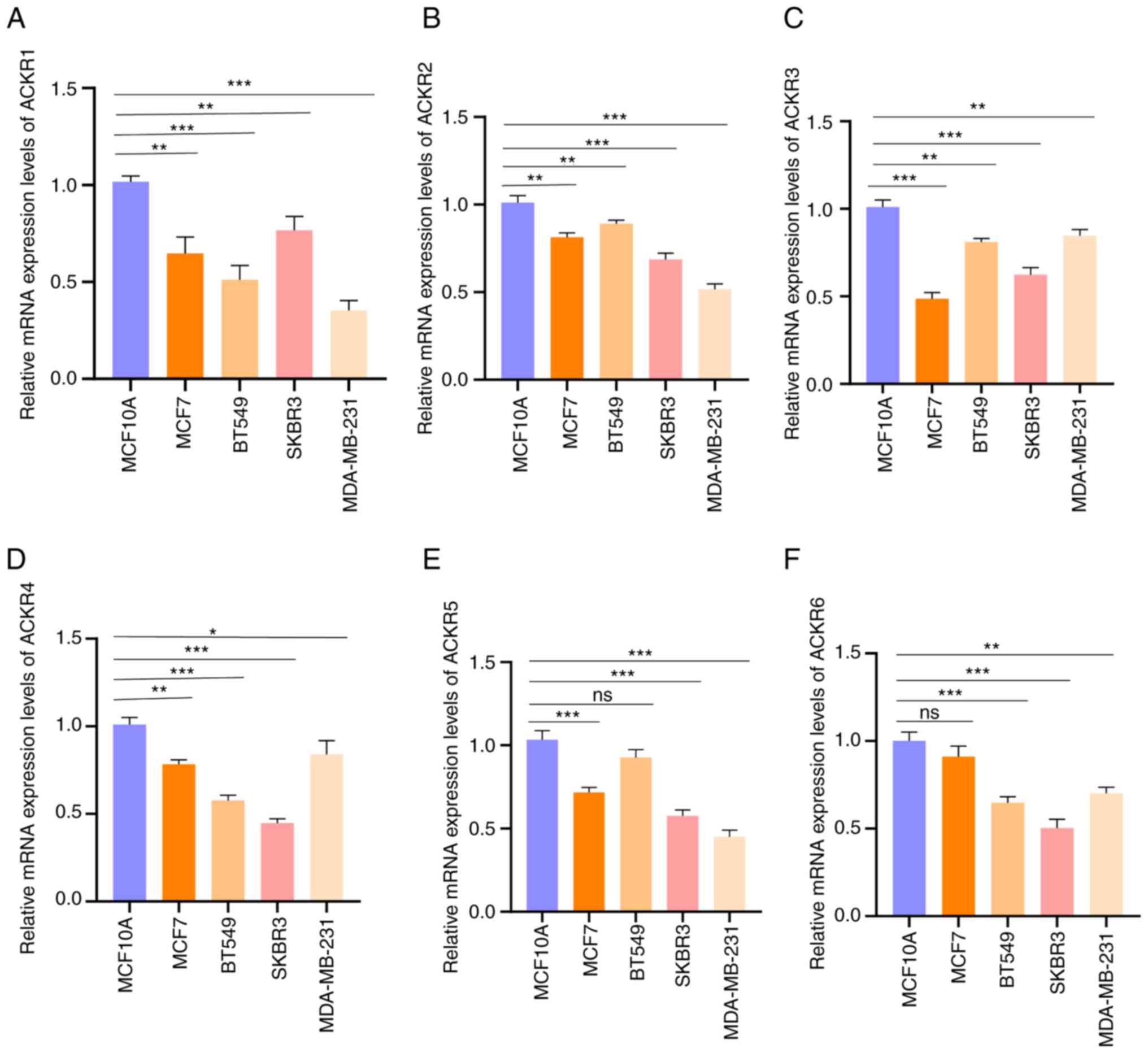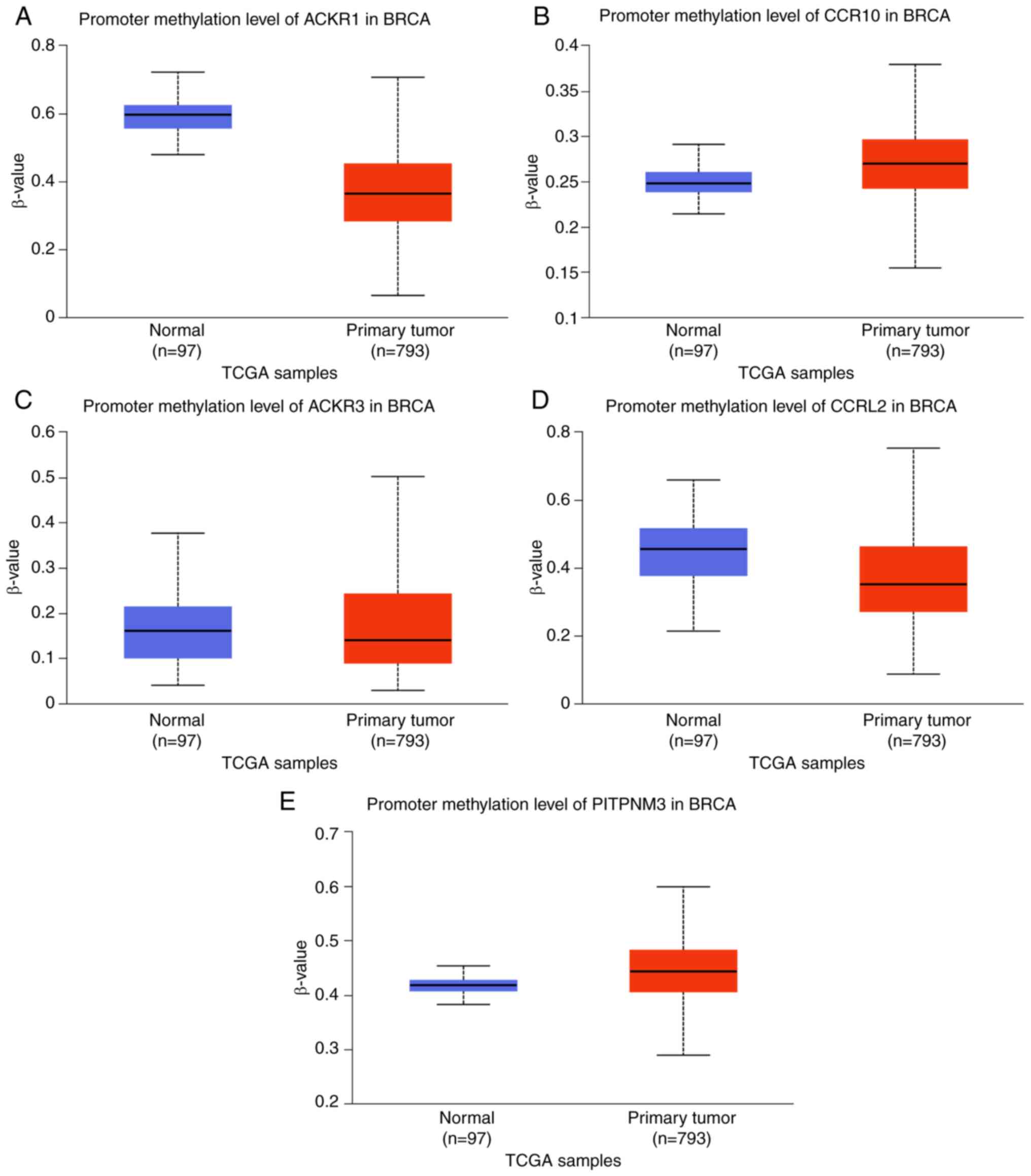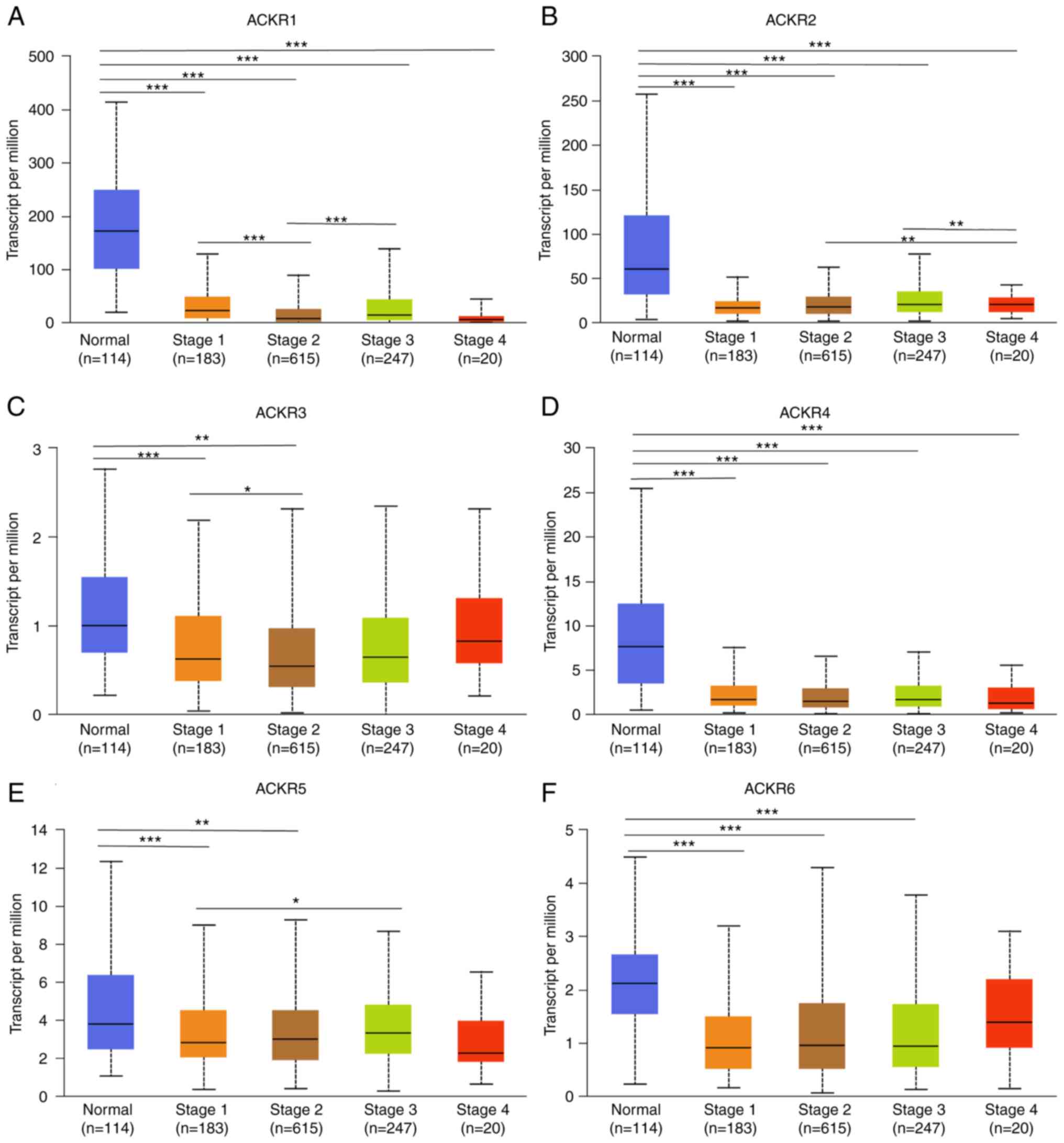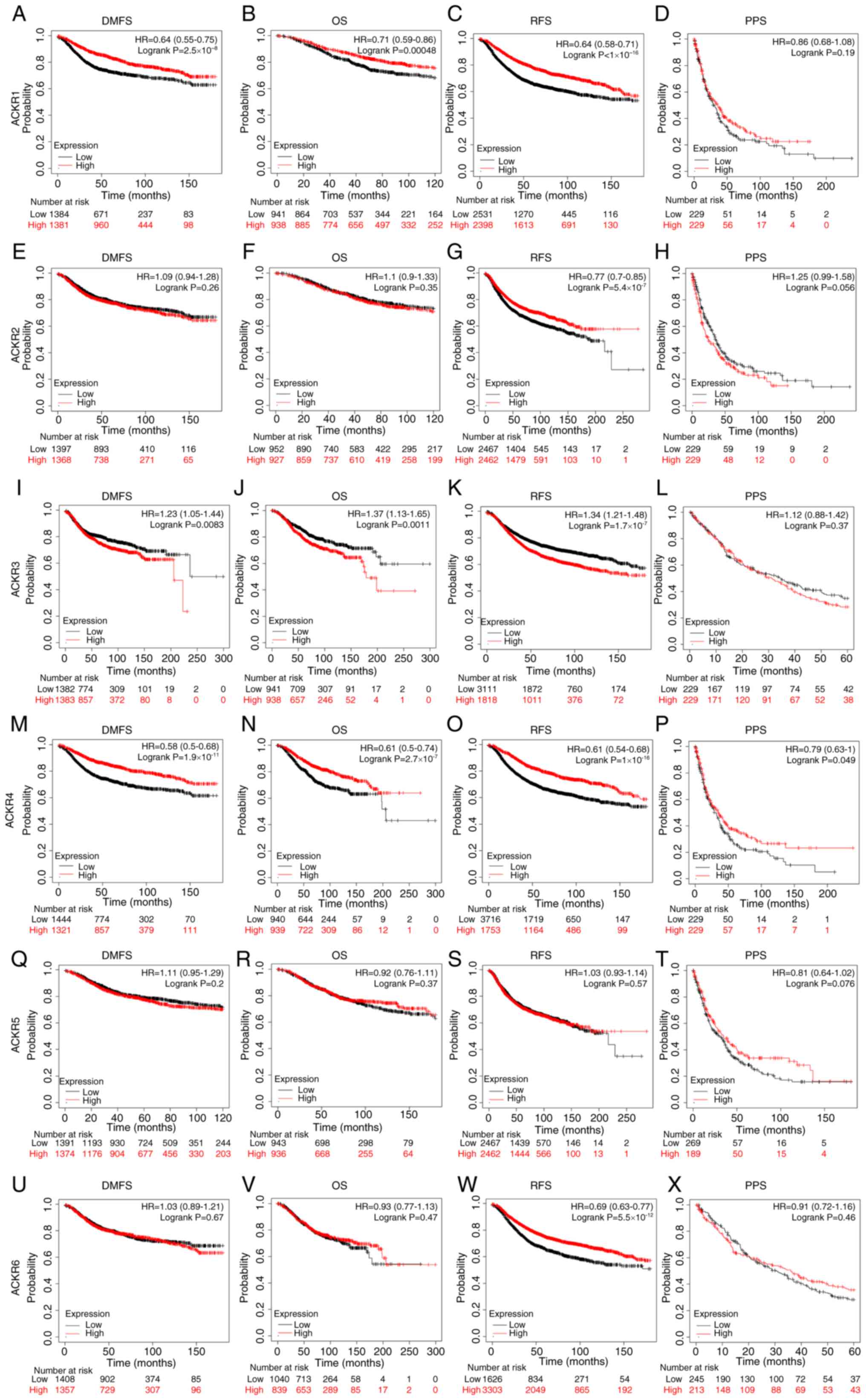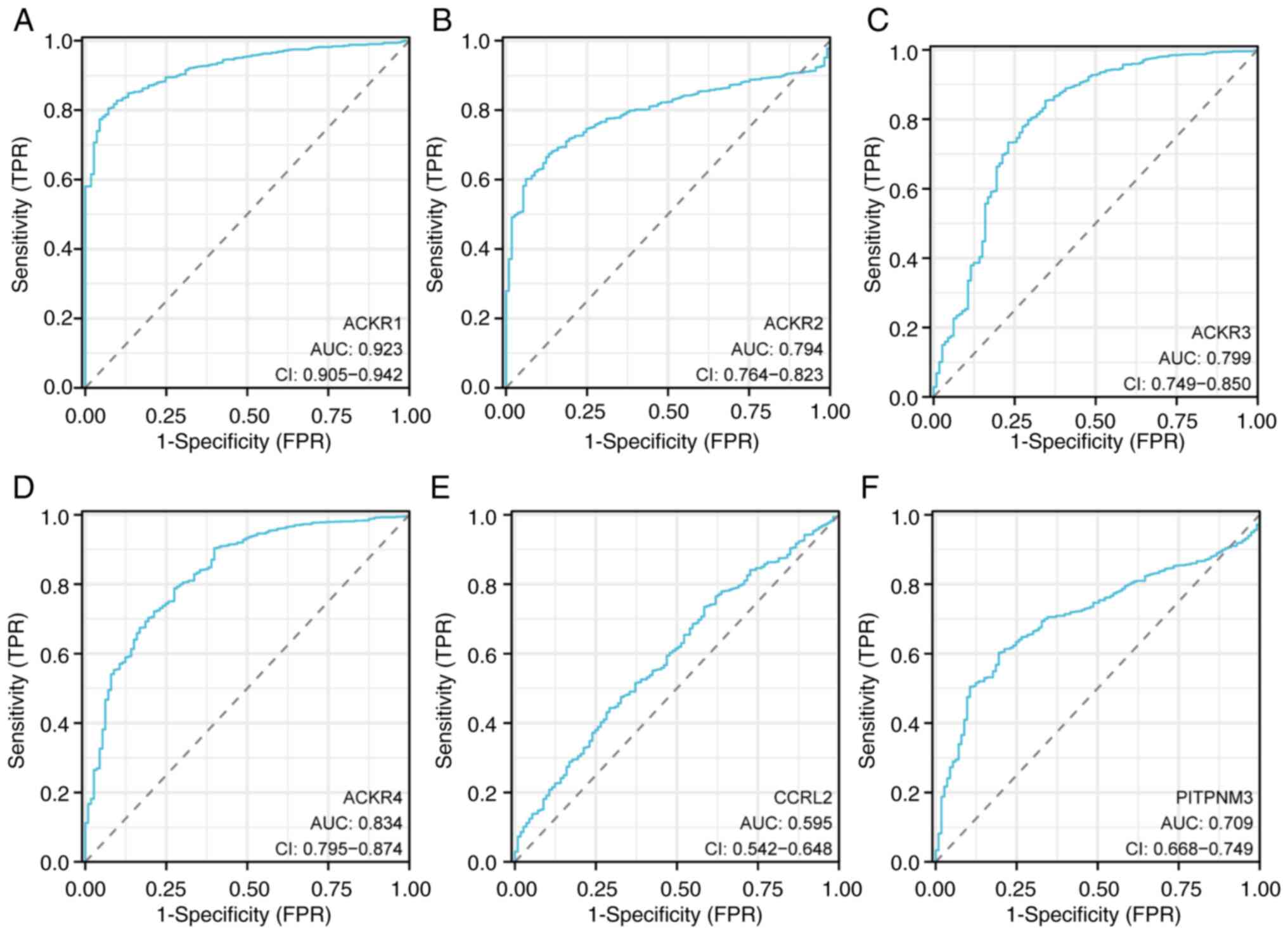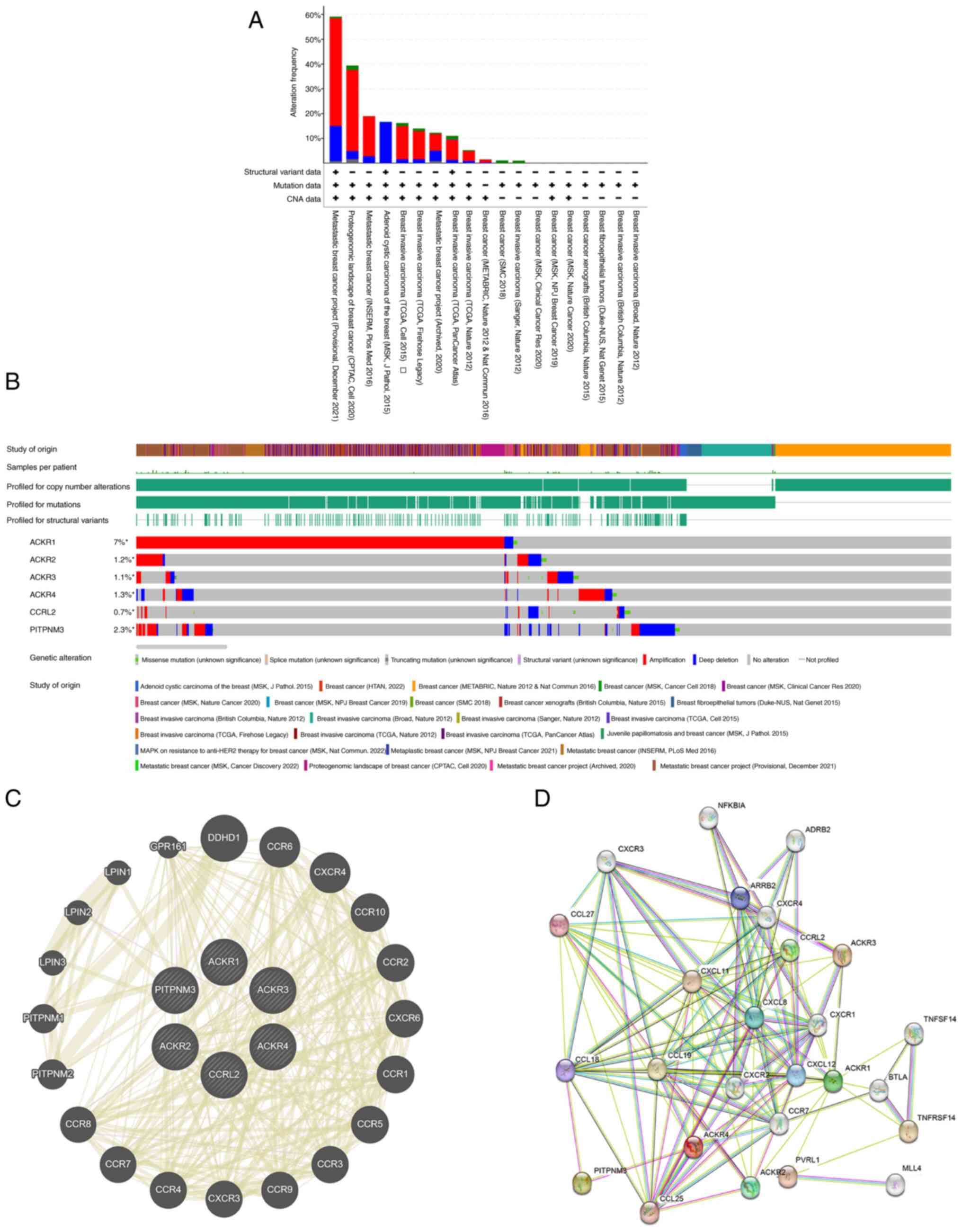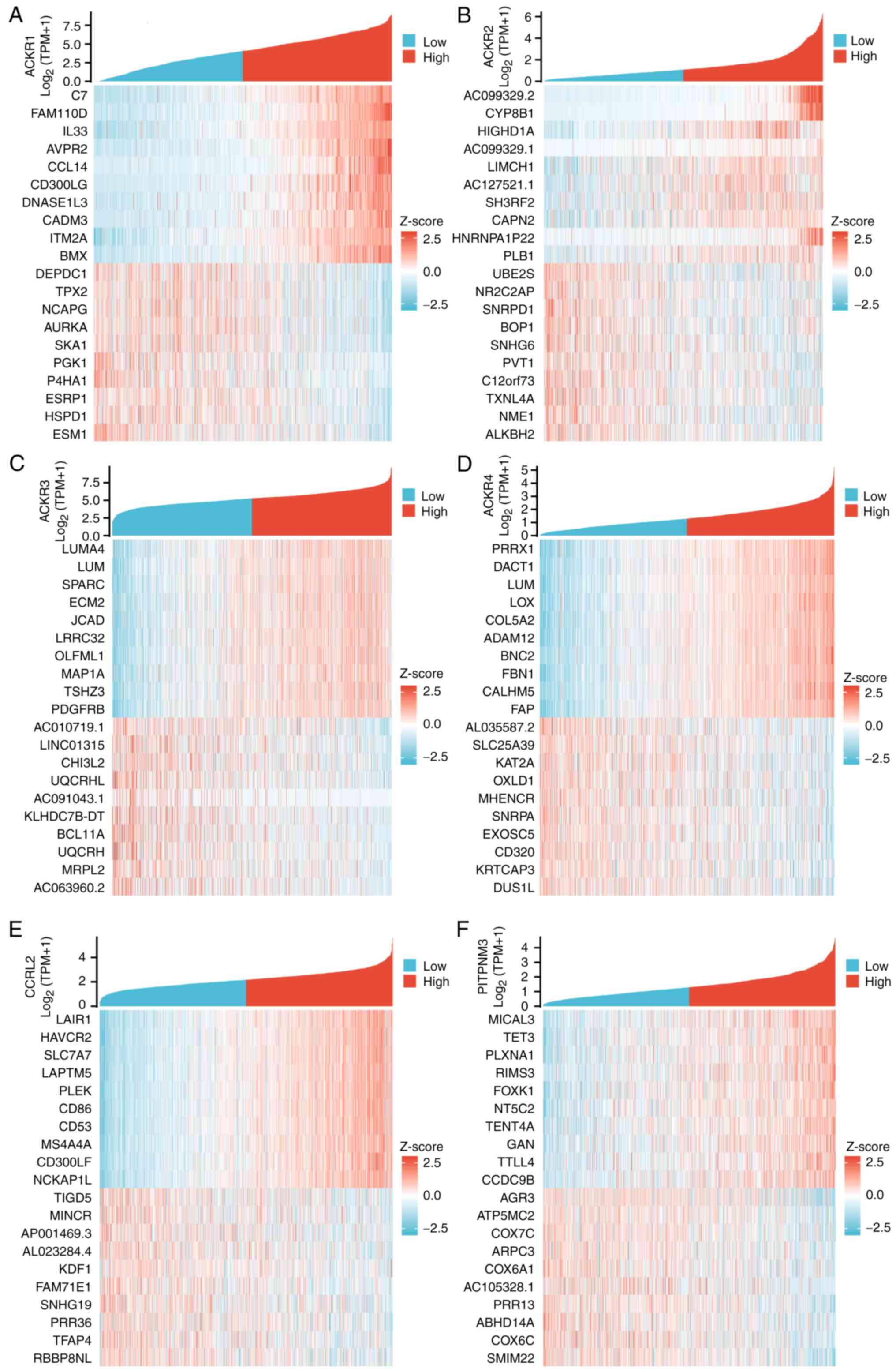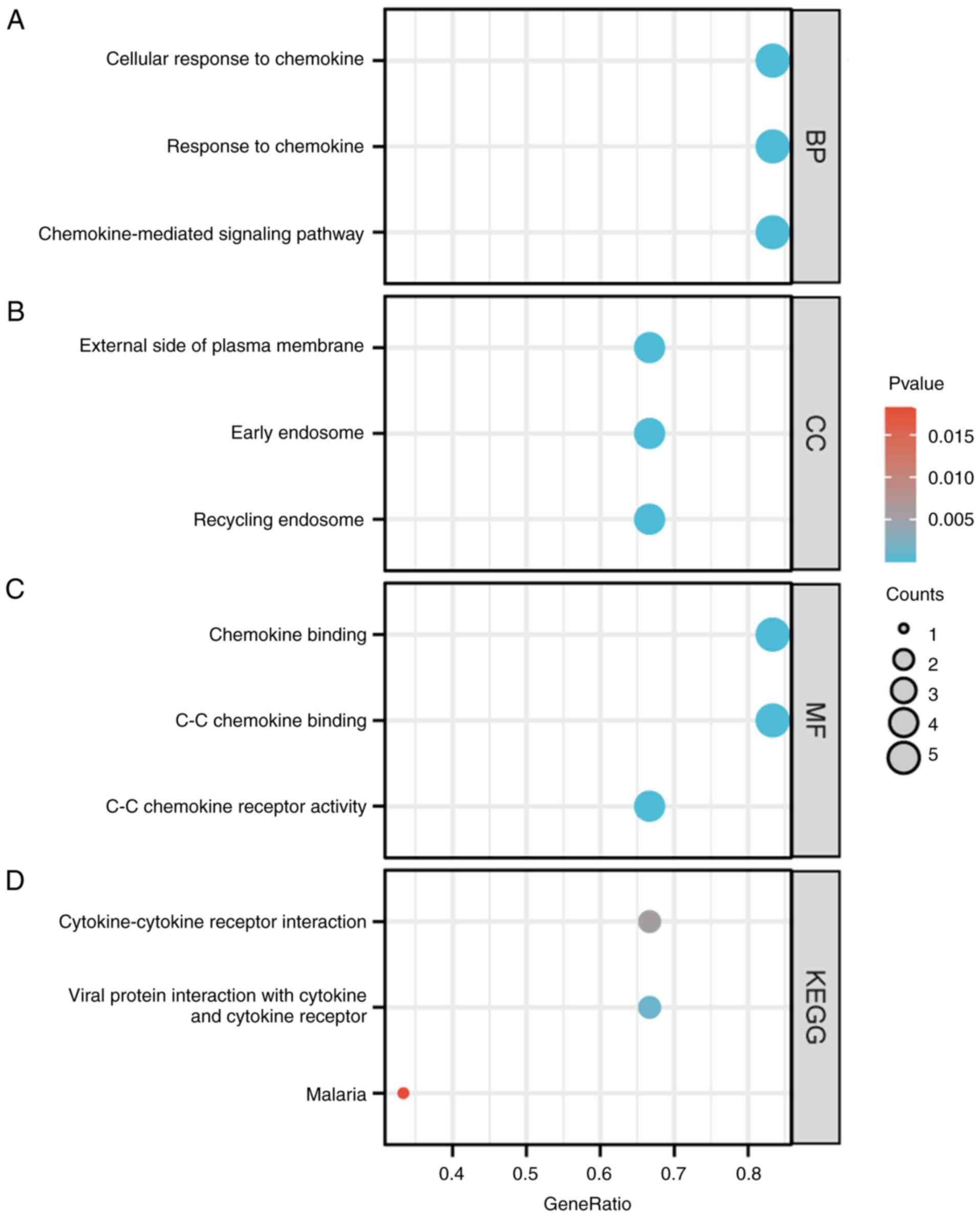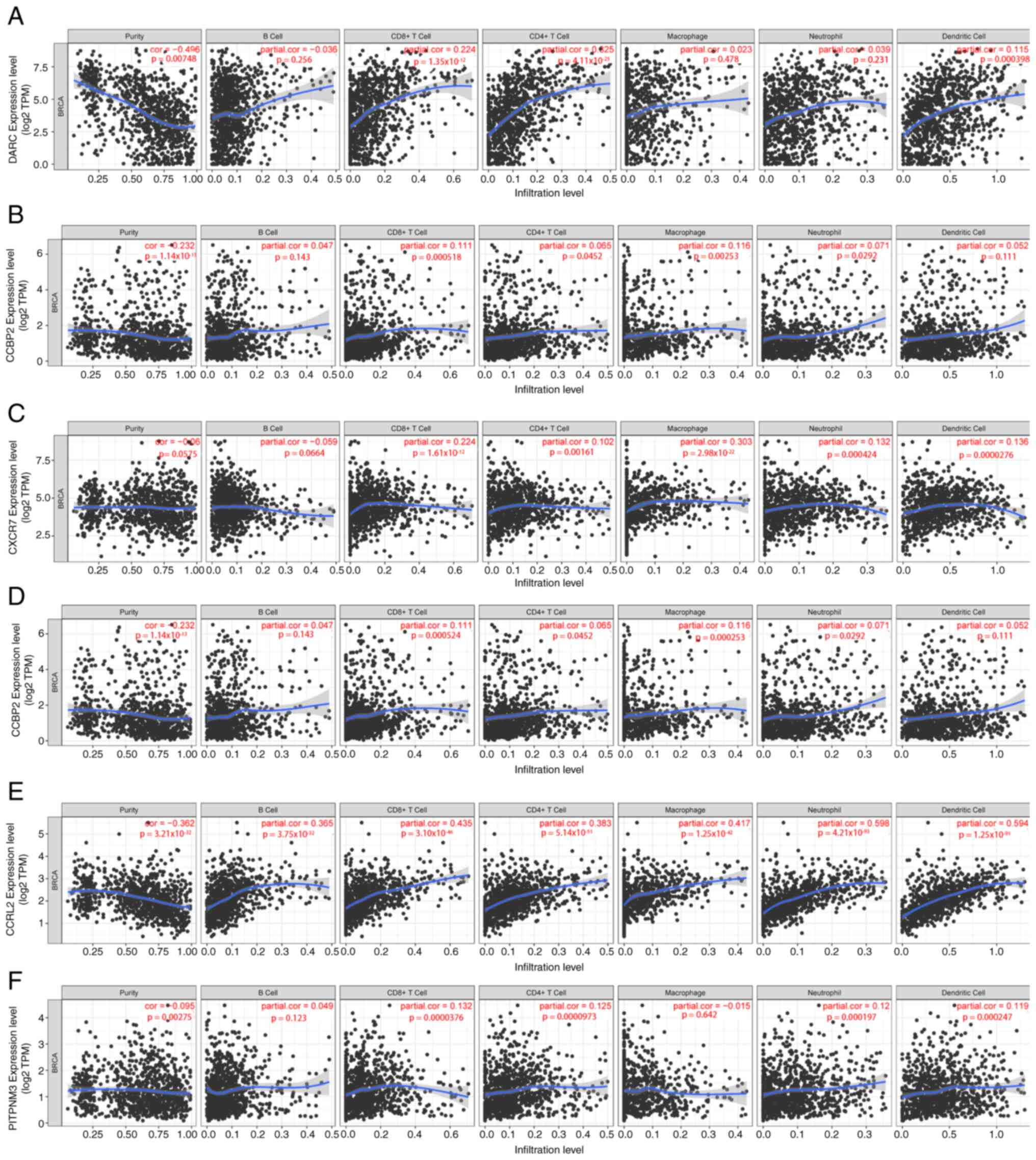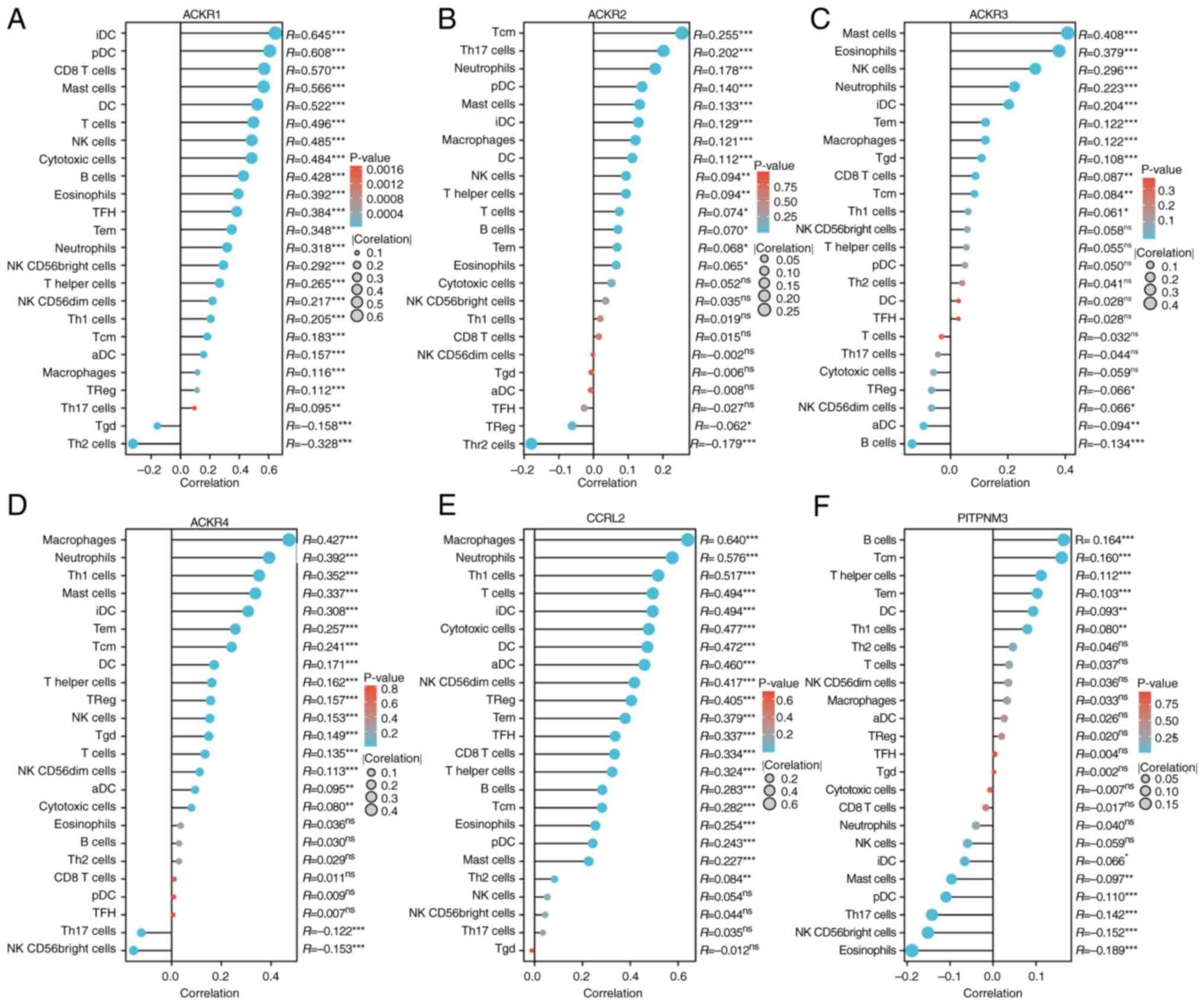Comprehensive analysis of ACKR family members in breast cancer using prognostic values
- Authors:
- Published online on: August 14, 2023 https://doi.org/10.3892/ol.2023.14011
- Article Number: 425
-
Copyright: © Yang et al. This is an open access article distributed under the terms of Creative Commons Attribution License.
Abstract
Introduction
Breast cancer (BC) is a prevalent cancer type among women, with an annual rate of 30 to 40/100,000 individuals in general, with a heterogeneous nature with marked differences between patients in terms of incidence, clinical outcome, response to treatment and prognosis (1,2). BC is classified according to a variety of factors, including expression of estrogen receptor (ER), progesterone receptor (PR) and human epidermal growth factor receptor 2 (HER2), and according to histological classification (3,4). BC has become the most common cancer worldwide, surpassing lung cancer, according to Global Cancer Data 2020 (5). Although the management strategies in place for BC have rapidly advanced, including early detection and effective therapies, metastatic disease continues to be a major contributor to poor prognosis (6,7). Given the limited availability of reliable biomarkers to accurately predict BC prognosis due to tumor heterogeneity, there is a need to identify new prognostic indicators and to design personalized treatments. Progress has been made with surgical techniques, chemotherapy, radiation therapy, hormone therapy and targeted therapies with respect to the diagnosis and treatment of early-stage BC, although the outlook for patients with advanced BC remains poor (6). Furthermore, recent data suggest that the majority of patients newly diagnosed with BC are already at an advanced stage. BC is recognized as a systemic disease by researchers around the world, and surgery remains the mainstay of treatment (8). Although surgery is the main treatment method for BC, its efficacy in the treatment of distant metastasis is limited. Endocrine therapy is only effective for patients with ER-positive and PR-positive BC; moreover, the rapid drug resistance that develops to chemotherapy and endocrine therapy reduces the benefits available to BC patients (9). This has led to the emergence of immunotherapy as a potentially effective systemic treatment for BC. However, despite decades of research, only a few immunotherapy strategies have been implemented in a clinical setting, and even fewer have shown promising therapeutic results (10).
Atypical chemokine receptors (ACKRs) have been reported to fulfill a crucial role in the regulation of chemokine availability via scavenging chemokines, and also have the potential to elicit downstream signaling via coupling to β-arrestin (11). However, conventional chemokine receptors have been reported to induce immune cell migration directly via G-protein-coupled signaling (12). The following have been reported as members of the ACKR family: ACKR1 [also known as Duffy antigen receptor for chemokines (DARC)], ACKR2 (D6), ACKR3 [C-X-C chemokine receptor type 7 (CXCR-7)], ACKR4 [C-C chemokine receptor type 11 (CCRL1)], ACKR5 (CCRL2) and ACKR6 [phosphatidylinositol transfer protein, membrane-associated, 3 (PITPNM3)]. Additionally, a recent study has reported that other receptors, including GPR182, GPR1 and C5aR2, that display some, or all, of the abnormal biological characteristics of ACKRs (13). These receptors, however, have not received as much attention as potential therapeutic targets in cancer due to a general lack of understanding of their biological function (14).
ACKRs have conventionally been understood to act solely as decoy or scavenger receptors, as they bind chemokines without triggering signaling coupled to downstream G-proteins (7). Tumor growth and metastasis are both mediated by the tumor cell expression of ACKRs, whereas antitumor immunity is mediated by the stromal cell expression of ACKRs (15). Certain receptors that are related to ACKRs, such as CCL2 and CXCL14, which serve important roles in tumor biology, have also been studied in recent years (16,17). Recent discoveries of additional ACKRs that have atypical properties, and an expanding understanding of the biological functions of ACKRs in cancer, both point to the need for further investigation of this subgroup of receptors as therapeutic targets in cancer (18–21). However, the specific functions and prognostic significance of individual ACKR family members in breast cancer (BC), remain both poorly defined and poorly understood. Therefore, the present study assessed the expression levels of ACKRs in breast carcinoma (BRCA) tissues compared with normal breast tissues through a series of database analyses, and the specific functions and prognostic significance of certain individual ACKR family members in BC were also explored.
Materials and methods
RNA-sequencing data and bioinformatics analysis
Normalized RNA sequencing data and associated clinical features were downloaded from The Cancer Genome Atlas (TCGA) in the Breast Invasive Cancer (TCGA BRCA) dataset, TCGA.BRCA.sampleMap/HiSeqV2_PANCAN (https://tcga.xenahubs.net). A total of 1,097 samples of BC tissue and 114 samples of healthy breast tissue were obtained. Transcript expression levels were estimated using the FPKM (fragments per kilobase per million fragments mapped) method for the high throughput sequencing data. Finally, the expression of ACKRs in adjacent benign tissues that were case-matched to BCs in TCGA database were paired for comparison using the Xiantao platform (https://www.xiantaozi.com/).
Cell lines and cell culture
The human MCF7, SK-BR3, BT549 and MDA-MB-231 BC cell lines, and the normal MCF10A mammary epithelial cell line were purchased from The Cell Bank of Type Culture Collection of The Chinese Academy of Sciences. SK-BR3, MCF-7, BT549 and MDA-MB-231 cells were cultured in DMEM (Gibco; Thermo Fisher Scientific, Inc.) supplemented with 10% (v/v) fetal bovine serum (Gibco; Thermo Fisher Scientific, Inc.) and 1% (v/v) penicillin/streptomycin solution (Beyotime Institute of Biotechnology). MCF10A cells were grown in MCF-10A cell medium (Procell Life Science & Technology Co., Ltd.). Standard cell culture techniques were used to grow and passage all cell lines in an incubator at 37°C in a 5% CO2 atmosphere.
University of ALabama at Birmingham CANcer data analysis Portal (UALCAN) database
Based on TCGA database, UALCAN (http://ualcan.path.uab.edu) is a comprehensive cancer data analysis website (22,23). Data on the mRNA expression of ACKRs and promoter methylation levels in BRCA and normal tissues (from healthy controls; TCGA-BRCA), as well as the associations between ACKR expression and clinicopathological parameters were assessed using UALCAN. The differences between ACKR mRNA expression and promoter methylation levels in BC and the matched controls (healthy controls) were assessed using Welch's t-test. Differences in ACKR expression among the different tumor substages were compared using one-way ANOVA with Dunnett's multiple-comparison test as the post-hoc test. P<0.05 was considered to indicate a statistically significant difference
ACKR-related gene function enrichment analyses
Differentially expressed genes (DEGs) were analyzed using R package (DESeq2, version 1.26.0). The threshold of log2FC >2 and adjusted P-value of <0.05 were chosen to consider genes as differentially expressed. Gene Ontology (GO) and Kyoto Encyclopedia of Genes and Genomes (KEGG) analyses were performed to evaluate potential gene functions associated with TPMs based on the TCGA database with R package (org.Hs.eg.db, version 3.10.0 and clusterProfiler, version 3.14.3).
Reverse transcription-quantitative (RT-q)PCR
Total RNA was extracted from the cell lines using the Total RNA Extraction Kit (Qiagen GmbH). cDNA was prepared using a HiScript®III First-Strand cDNA Synthesis Kit (+gDNA wiper) (Vazyme Biotech Co., Ltd.) according to the manufacturer's instructions. Subsequently, qPCR was performed using ChamQ Universal SYBR qPCR Master Mix (Vazyme Biotech Co., Ltd.). Primers were synthesized by GenScript. The reaction steps were as follows: i) pre-denaturation at 95°C for 30 sec; ii) PCR reaction of 40 cycles at 95°C for 5 sec, followed by incubation at 60°C for 30 sec. The sequences of the β-actin and the ACKR primers are presented in Table I. Cycle thresholds were recorded and the relative expression of target genes was calculated and quantified using the 2−∆∆Cq method with β-actin as the reference gene (24).
Tumor immune estimation resource (TIMER)
TIMER 2.0 (https://cistrome.shinyapps.io/timer/) is an intuitive web interface with six basic analysis modules for the systematic assessment of numerous types of immune cell infiltration and their clinical impact (25). ACKRs were selected as the input using the gene module and scatterplots were generated for the purposes of visualizing the correlation between their expression levels and the level of immune infiltration in BC.
Gene expression profiling interactive analysis (GEPIA)
GEPIA (http://gepia.cancer-pku.cn/index.html, accessed December 21, 2017) is an analytical tool that uses standard processing procedures which incorporate data from thousands of normal and cancer tissue samples (26). In the present study, GEPIA was used to analyze differential gene expression between tumor and normal tissues. Pathological staging analysis and associated prognosis analysis were also performed. Statistical analysis of expression levels or pathological stage analysis were performed using Welch's t-test. Patient survival was also analyzed using Kaplan-Meier curves for further validation.
cBioPortal
The cBio Cancer Portal (cBioPortal) is a comprehensive web resource which provides multidimensional visualization and access to cancer genomics data (www.cbioportal.org) (27). In the present study, gene mutations of ACKRs in BRCA were analyzed using this resource.
GeneMANIA
GeneMANIA (http://www.genemania.org) is a resource-rich website for gene information, gene list analysis and high-precision prediction algorithm-prioritized gene function analysis. This website was used to establish the ACKR interaction networks.
STRING
The STRING online database (https://string-db.org/) is a website for the investigation of protein-protein interactions (PPIs). Through the PPI network analysis of STRING, the different expression levels and potential PPIs of ACKRs were identified and assessed.
Statistical analysis
GraphPad Prism software (version 8.0; Dotmatics) and R (https://www.r-project.org; version 3.6.3) were used for statistical analysis. Transcriptional data and clinical data for BRCA were also downloaded from TCGA database, subjected to one-way Cox regression analysis, and analyzed using the R software package ‘Forestplot’ (version 2.0.1; http://CRAN.R-project.org/package=forestplot). Receiver operating characteristic (ROC) curves were drawn using ‘pROC’ package (version 1.18.0; http://CRAN.R-project.org/package=pROC) in R. Finally, multivariate analysis of overall survival (OS), distant metastasis-free survival (DMFS), post-progression survival (PPS) and recurrence free survival (RFS) were performed using the ‘survival’ package (version 3.2, year 13; http://CRAN.R-project.org/package=survival) in R. The correlation between ACKRs expression and immune infiltration was evaluated by Spearman's correlation analysis. P<0.05 was considered to indicate a statistically significant difference.
Results
ACKR expression and promoter methylation in patients with BRCA
The expression of ACKRs in patients with BRCA was assessed using the UALCAN and GEPIA databases. The mRNA expression levels of ACKR1 (Figs. 1A and 2A), ACKR3 (Figs. 1C and 2C) and ACKR4 (Figs. 1D and 2D) were demonstrated to be significantly upregulated in BRCA compared with normal tissues. The expression of levels of ACKRs in the normal BC cells (MCF-10A, MCF7, SKBR3 and MDA-MB-231) were assessed using RT-qPCR. Consistent with the aforementioned results, markedly higher expression levels of the ACKRs were detected in BRCA cells compared with normal MCF10A cells, except ACKR5 in BT549 and ACKR6 in MCF7 (Fig. 3). Furthermore, promoter methylation was demonstrated to be notably correlated with BC progression. Marked hypermethylation was demonstrated in the ACKR2 promoter (Fig. 4B) and in the ACKR6 promoter (Fig. 4E). However, marked hypomethylation was demonstrated in the ACKR1 (Fig. 4A), ACKR3 (Fig. 4C) and ACKR5 (Fig. 4D) promoters.
Association between ACKRs and the cancer stages of patients with BRCA
Data from the UALCAN database demonstrated that BC stage was markedly negatively correlated with the expression of ACKR1 (Fig. 5A), ACKR2 (Fig. 5B), ACKR3 (Fig. 5C), ACKR4 (Fig. 5D), ACKR5 (Fig. 5E) and ACKR6 (Fig. 5F). These findings suggested that the expression levels of ACKRs were closely associated with the staging of patients with BRCA.
Prognostic and diagnostic value of ACKR mRNA expression in patients with BC
To assess the value of differently expressed ACKRs in determining BC progression, the correlation between different ACKRs and clinical outcomes was analyzed using Kaplan-Meier plots. A low expression of ACKR1 (Fig. 6A) was significantly correlated with a shorter DMFS in patients with BC. Furthermore, low mRNA expression levels of ACKR1 (Fig. 6B and C), ACKR4 (Fig. 6N and O) and ACKR6 (Fig. 6W) were significantly correlated with shorter recurrence-free survival (RFS) times and shorter OS times in patients with BC. In addition, a high mRNA expression level of ACKR3 (Fig. 6I-K) was demonstrated to be significantly correlated with shorter RFS, OS and DMFS times in patients with BC. A low mRNA expression level of ACKR4 (Fig. 6P) was a predictor of shorter PPS in patients with BC, while other effects of ACKRs were not significant (Fig. 6). Furthermore, it was demonstrated that ACKRs had high accuracy in terms of both diagnosing BC and differentiating BC from the normal controls (Fig. 7).
Changes in expression of ACKR genes, and expression and interaction analysis of ACKR genes in patients with BRCA
The genetic alterations affecting the expression of ACKR family genes in BC were examined using the cBioPortal web tool. The ACKR family members (ACKR1, ACKR2, ACKR3, ACKR4, ACKR5 and ACKR6) were changed in 7.0, 1.2, 1.1, 1.3, 0.7 and 2.3% of the BC samples, respectively (Fig. 8A and B). A PPI network analysis of PPIs was subsequently performed on the differentially expressed ACKRs using the STRING website, and possible interactions between the ACKRs were investigated. Multiple nodes and edges were presented in the PPI network (Fig. 8C). The GeneMANIA database was used to establish the gene interaction networks. Fig. 8D indicated that the network involved links between 6 ACKRs and several other closely related genes, including DDHD1, CCR8, CXCR4, CCR10, CCR2, CXCR6, CCR1, CCR5, CCR3 and CCR9.
BC TCGA, gene ontology (GO) and Kyoto Encyclopedia of Genomes (KEGG) analyses of ACKRs and their co-expressed genes
The TCGA database software package DEseq2 R was used to analyze differentially expressed genes in patients with BC with either high or low expression of ACKR. The top 10 top 10 genes that were positively or negatively correlated with ACKRs in BC were identified (Fig. 9). GO and KEGG enrichment analyses using the top 100 differentially expressed genes that were mainly positively correlated with ACKRs were subsequently performed. Condensed GO analysis information for biological processes (BP), cellular composition (CC) and molecular functions (MF). From the perspective of BP, ‘chemokine-mediated signaling pathways’, ‘cellular response to chemokine’ and ‘response to chemokine’ were found to be significantly enriched for ACKRs and their associated genes. KEGG analysis terms, were enriched in ‘cytokine-cytokine receptor interactions’, ‘viral protein interaction with cytokine and cytokine receptor’ and ‘malaria’ (Fig. 10).
ACKR immune cell infiltration in patients with BC
The concentration of immune cells has previously been reported to be associated with the proliferation and progression of cancer cells (28). In the present study, the TIMER database was used to examine the association between ACKR members and immune cell infiltration. The expression of ACKR1 was demonstrated to be significantly associated with the infiltration of CD4+ T cells, CD8+ T cells and dendritic cells in patients with BC (Fig. 11A). ACKR2 was significantly positively correlated with the infiltration of CD8+ T cells, B cells, CD4+ T cells, macrophages and neutrophils in patients with BC (Fig. 11B). The expression of ACKR3 was significantly positively correlated with the infiltration of CD8+ T cells, CD4+ T cells, macrophages and neutrophils in BC (Fig. 11C). Furthermore, the expression of ACKR4 in patients with BC was markedly positively correlated with the infiltration rates of CD4+ T cells, CD8+ T cells, macrophages and neutrophils (Fig. 11D). The expression of ACKR5 was found to be significantly positively correlated with all six host immune cell types (B cells, CD8+ T cells, CD4+ T cells, macrophages, neutrophils and dendritic cells) in patients with BC (Fig. 11E). Finally, the expression of ACKR6 in colorectal cancer was found to be significantly positively correlated with the infiltration of CD8+ T cells, CD4+ T cells, neutrophils and dendritic cells (Fig. 11F).
To further assess the effect of ACKRs on the tumor microenvironment (TME), the correlation between ACKRs and immune cell infiltration was evaluated using Spearman's correlation analysis. This demonstrated that ACKRs were correlated both positively and negatively with numerous types of immune cells; for example, Tcm, T helper cells and Tem were consistently positive correlated with all ACKRs (Fig. 12).
Discussion
BC is known to be a highly heterogeneous malignancy, which presents challenges in terms of its diagnosis and treatment due to the differences among individual cases. A previous study suggested that the identification of novel therapeutic targets for BC may be a viable strategy to address its heterogeneity (28). Therefore, it is critical to explore the mechanisms which underlie BC initiation and progression, and to identify disease-associated biomarkers in order to develop effective strategies for the diagnosis, treatment and prognostic assessment of BC.
Traditional chemokines and chemokine receptors fulfill key roles in the regulation of immune cell migration and the control of immune cell composition in the TME, and have been reported as potential targets for cancer therapy (29). However, ACKRs, as a subfamily of chemokine receptors, have received less attention as cancer therapeutic targets due to their unclear biological function (12). ACKRs were originally considered to function solely as decoy or scavenger receptors as they were able to bind chemokines without activating signaling coupled to downstream G-proteins, which differentiates them from classical chemokine receptors. In the present study, the expression, mutation status, prognostic value and immune cell infiltrates of ACKRs in BC were evaluated.
ACKRs have also been previously assessed in other settings, in addition to their potential role in BC. ACKR1, for example, has been reported to regulate hematopoiesis in nucleated erythroid cells, and its deficiency has been reported to be associated with reduced atherogenesis in ApoE-knockout mice (30,31). These studies suggested that ACKRs may serve important functions in addition to their role in cancer, and further investigation is required to fully understand their biological significance. Graham (32) speculated that ACKR1 could be a tumor suppressor, which could serve as a predictive factor for the treatment of cervical cancer. ACKR2 receptor has been reported to have anti-oncogenic properties in several human tumor types (32). Indeed, its expression was previously shown to be correlated with improved outcomes in gastric cancer and cervical squamous cell carcinoma, and to lead to an inhibition of proliferation of lung cancer cells and tumorigenesis (32). ACKR2 has also been reported to delay tumor progression in Kaposi's sarcoma through the inhibition of the inflammatory chemokines, chemokine ligand (CCL)-2, CCL-5 and CCL-3, thereby reducing the infiltration of macrophages and angiogenesis (33,34). Although further studies are required to fully elucidate the underlying mechanism of the action of ACKR2 in BC, as well as its potential as a therapeutic target (16). ACKR4 is an important member of the ACKR family, which functions as a scavenger receptor for homoeostatic chemokines, such as CCL19, CCL21, CCL25 and CXCL13 (17). Although the mechanism by which ACKRs function as scavengers has yet to be fully elucidated, it is well established that ACKR4 spontaneously moves between the plasma membrane and endosomes, with β-arrestins regulating its trafficking at the steady state and promoting chemokine uptake (17). It has been suggested that ACKR4 may impair the migratory and invasive properties of colorectal cancer cells, potentially through a reduction in the protein levels of CCR7 (34). In addition, PITPNM3 is the functional receptor for CCL18, which may become phosphorylated and subsequently initiate a cascade of events, including the activation of praline-rich tyrosine kinase (Pyk2), a crucial component of the focal adhesion complex (FAC) (19). ACKR3 (CXCR7) is an atypical chemokine receptor with seven transmembrane domains, belonging to the AG class of G-protein-coupled receptors (35). Notably, altered ACKR3 expression levels have also been reported in numerous types of cancers, including prostate, kidney, liver, cervix, brain, lung cancer and BC (36,37).
It is noteworthy that, in the present study, we found that ACKR family members were downregulated in breast cancer tissues, which suggested that ACKRs may serve a role in tumor development. It was also demonstrated that ACKRs may serve important roles in the development of different pathological stages of breast cancer based on the correlation between the differential expression of the ACKR gene family and the pathological stages of patients with breast cancer. These may serve as targets for guiding the treatment of patients with different stages in future clinical practice.
To evaluate the link between prognosis and the ACKR gene families in patients with breast cancer, biological analysis was performed, which demonstrated that higher expression of certain ACKRs were correlated with better survival in patients with all types of breast cancer. For example, the present study demonstrated that elevated transcriptional levels of ACKR2 were significantly associated with longer OS times in patients with BC, which suggested a potential role for ACKR2 as a favorable prognostic biomarker. However, the expression level of ACKR3 was found to be significantly lower in BC tumor tissues compared with normal breast tissues, although in the prognostic analysis, the OS rate of the ACKR3 high-expression group was worse compared with that of the low-expression group. In tumor tissues, there are not only tumor cells, but also mesenchymal tissue and immune cells (38). In breast tumor tissues, ACKR3 was positively correlated with the levels of immune cells, including mast cells, eosinophils, neutrophils, natural killer cells, macrophages and CD8+ T cells, and may have a potential immunomodulatory role, which could be associated with poor prognosis for patients with BC. In conclusion, the TME is an area of research which has attracted an increasing level of interest, as it has been reported to have an impact on tumor progression and recurrence (38,39). The presence of immune cells in the TME can either promote or suppress tumor growth, and therefore these are an important determinant of clinical outcome and response to immune therapy (29,40). The present study demonstrated that the expression of ACKRs was highly correlated with the infiltration of six types of immune cells in BC, which suggested that ACKRs may serve as a marker of immune status, in addition to predicting the disease prognosis of BC. This study may be useful in the field of breast cancer treatment and may assist in the development of new immunotherapies.
There were some limitations to the present study. All the data analyzed in the study were retrieved from online databases and cell lines, and further studies consisting of clinical studies and additional cell experiments are required to validate the findings and to further explore the potential mechanisms, molecules interactions and clinical applications of distinct ACKRs in BC.
Although further studies are needed to validate these results, the present study has provided a rationale for the discovery of novel targets and prognostic markers for BRCA therapy.
Acknowledgements
Not applicable.
Funding
This study was funded by Xingtai City Key Research and Development Plan (grant no. 2021ZC148) and the Scientific Research Fund of Health Commission of Hebei Province (grant no. 20220224).
Availability of data and materials
The datasets used and/or analyzed during the current study are available from the corresponding author on reasonable request.
Authors' contributions
LY designed the study and wrote the article. SZ and PP performed the literature searches and data analysis. SZ and PP confirm the authenticity of all the raw data. All the authors have read and approved the final manuscript.
Ethics approval and consent to participate
Not applicable.
Patient consent for publication
Not applicable.
Competing interests
The authors declare that they have no competing interests.
References
|
Sung H, Ferlay J, Siegel RL, Laversanne M, Soerjomataram I, Jemal A and Bray F: Global cancer statistics 2020: GLOBOCAN estimates of incidence and mortality worldwide for 36 cancers in 185 countries. CA Cancer J Clin. 71:209–249. 2021. View Article : Google Scholar : PubMed/NCBI | |
|
Stephens PJ, Tarpey PS, Davies H, Van Loo P, Greenman C, Wedge DC, Nik-Zainal S, Martin S, Varela I, Bignell GR, et al: The landscape of cancer genes and mutational processes in breast cancer. Nature. 486:400–404. 2012. View Article : Google Scholar : PubMed/NCBI | |
|
Saad ED, Squifflet P, Burzykowski T, Quinaux E, Delaloge S, Mavroudis D, Perez E, Piccart-Gebhart M, Schneider BP, Slamon D, et al: Disease-free survival as a surrogate for overall survival in patients with HER2-positive, early breast cancer in trials of adjuvant trastuzumab for up to 1 year: A systematic review and meta-analysis. Lancet Oncol. 20:361–370. 2019. View Article : Google Scholar : PubMed/NCBI | |
|
Nik-Zainal S, Alexandrov LB, Wedge DC, Van Loo P, Greenman CD, Raine K, Jones D, Hinton J, Marshall J, Stebbings LA, et al: Mutational processes molding the genomes of 21 breast cancers. Cell. 149:979–993. 2012. View Article : Google Scholar : PubMed/NCBI | |
|
Lischka A, Doberstein N, Freitag-Wolf S, Koçak A, Gemoll T, Heselmeyer-Haddad K, Ried T, Auer G and Habermann JK: Genome instability profiles predict disease outcome in a cohort of 4,003 patients with breast cancer. Clin Cancer Res. 26:4606–4615. 2020. View Article : Google Scholar : PubMed/NCBI | |
|
Aushev VN, Lee E, Zhu J, Gopalakrishnan K, Li Q, Teitelbaum SL, Wetmur J, Degli Esposti D, Hernandez-Vargas H, Herceg Z, et al: Novel predictors of breast cancer survival derived from miRNA activity analysis. Clin Cancer Res. 24:581–591. 2018. View Article : Google Scholar : PubMed/NCBI | |
|
Shachar SS, Deal AM, Weinberg M, Williams GR, Nyrop KA, Popuri K, Choi SK and Muss HB: Body composition as a predictor of toxicity in patients receiving anthracycline and taxane-based chemotherapy for early-stage breast cancer. Clin Cancer Res. 23:3537–3543. 2017. View Article : Google Scholar : PubMed/NCBI | |
|
Duraker N, Hot S, Akan A and Nayır PÖ: A comparison of the clinicopathological features, metastasis sites and survival outcomes of invasive lobular, invasive ductal and mixed invasive ductal and lobular breast carcinoma. Eur J Breast Health. 16:22–31. 2020. View Article : Google Scholar : PubMed/NCBI | |
|
Lobbezoo DJA, van Kampen RJ, Voogd AC, Dercksen MW, van den Berkmortel F, Smilde TJ, van de Wouw AJ, Peters FP, van Riel JM, Peters NA, et al: Prognosis of metastatic breast cancer subtypes: The hormone receptor/HER2-positive subtype is associated with the most favorable outcome. Breast Cancer Res Treat. 141:507–514. 2013. View Article : Google Scholar : PubMed/NCBI | |
|
Yang J: Lack of robust prognostic biomarkers for immunotherapy in breast cancer-adverse events. JAMA Oncol. 5:1639–1640. 2019. View Article : Google Scholar : PubMed/NCBI | |
|
Lokeshwar BL, Kallifatidis G and Hoy JJ: Atypical chemokine receptors in tumor cell growth and metastasis. Adv Cancer Res. 145:1–27. 2020. View Article : Google Scholar : PubMed/NCBI | |
|
Griffith JW, Sokol CL and Luster AD: Chemokines and chemokine receptors: Positioning cells for host defense and immunity. Annu Rev Immunol. 32:659–702. 2014. View Article : Google Scholar : PubMed/NCBI | |
|
Li XX, Lee JD, Kemper C and Woodruff TM: The complement receptor C5aR2: A powerful modulator of innate and adaptive immunity. J Immunol. 202:3339–3348. 2019. View Article : Google Scholar : PubMed/NCBI | |
|
Nagarsheth N, Wicha MS and Zou W: Chemokines in the cancer microenvironment and their relevance in cancer immunotherapy. Nat Rev Immunol. 17:559–572. 2017. View Article : Google Scholar : PubMed/NCBI | |
|
Xu S, Tang J, Wang C, Liu J, Fu Y and Luo Y: CXCR7 promotes melanoma tumorigenesis via Src kinase signaling. Cell Death Dis. 10:1912019. View Article : Google Scholar : PubMed/NCBI | |
|
Sjöberg E, Meyrath M, Milde L, Herrera M, Lövrot J, Hägerstrand D, Frings O, Bartish M, Rolny C, Sonnhammer E, et al: A novel ACKR2-dependent role of fibroblast-derived CXCL14 in epithelial-to-mesenchymal transition and metastasis of breast cancer. Clin Cancer Res. 25:3702–3717. 2019. View Article : Google Scholar : PubMed/NCBI | |
|
Whyte CE, Osman M, Kara EE, Abbott C, Foeng J, McKenzie DR, Fenix KA, Harata-Lee Y, Foyle KL, Boyle ST, et al: ACKR4 restrains antitumor immunity by regulating CCL21. J Exp Med. 217:e201906342020. View Article : Google Scholar : PubMed/NCBI | |
|
Del Prete A, Martínez-Muñoz L, Mazzon C, Toffali L, Sozio F, Za L, Bosisio D, Gazzurelli L, Salvi V, Tiberio L, et al: The atypical receptor CCRL2 is required for CXCR2-dependent neutrophil recruitment and tissue damage. Blood. 130:1223–1234. 2017. View Article : Google Scholar : PubMed/NCBI | |
|
Lin Z, Li W, Zhang H, Wu W, Peng Y, Zeng Y, Wan Y, Wang J and Ouyang N: CCL18/PITPNM3 enhances migration, invasion, and EMT through the NF-κB signaling pathway in hepatocellular carcinoma. Tumour Biol. 37:3461–3468. 2016. View Article : Google Scholar : PubMed/NCBI | |
|
Le Mercier A, Bonnavion R, Yu W, Alnouri MW, Ramas S, Zhang Y, Jäger Y, Roquid KA, Jeong HW, Sivaraj KK, et al: GPR182 is an endothelium-specific atypical chemokine receptor that maintains hematopoietic stem cell homeostasis. Proc Natl Acad Sci USA. 118:e20215961182021. View Article : Google Scholar : PubMed/NCBI | |
|
Yin W, Li Y, Song Y, Zhang J, Wu C, Chen Y, Miao Y, Lin C, Lin Y, Yan D, et al: CCRL2 promotes antitumor T-cell immunity via amplifying TLR4-mediated immunostimulatory macrophage activation. Proc Natl Acad Sci USA. 118:e20241711182021. View Article : Google Scholar : PubMed/NCBI | |
|
Chandrashekar DS, Bashel B, Balasubramanya SAH, Creighton CJ, Ponce-Rodriguez I, Chakravarthi BVSK and Varambally S: UALCAN: A portal for facilitating tumor subgroup gene expression and survival analyses. Neoplasia. 19:649–658. 2017. View Article : Google Scholar : PubMed/NCBI | |
|
Chandrashekar DS, Karthikeyan SK, Korla PK, Patel H, Shovon AR, Athar M, Netto GJ, Qin ZS, Kumar S, Manne U, et al: UALCAN: An update to the integrated cancer data analysis platform. Neoplasia. 25:18–27. 2022. View Article : Google Scholar : PubMed/NCBI | |
|
Livak KJ and Schmittgen TD: Analysis of relative gene expression data using real-time quantitative PCR and the 2(−Delta Delta C(T)) method. Methods. 25:402–408. 2001. View Article : Google Scholar : PubMed/NCBI | |
|
Li T, Fan J, Wang B, Traugh N, Chen Q, Liu JS, Li B and Liu XS: TIMER: A web server for comprehensive analysis of tumor-infiltrating immune cells. Cancer Res. 77:e108–e110. 2017. View Article : Google Scholar : PubMed/NCBI | |
|
Tang Z, Li C, Kang B, Gao G, Li C and Zhang Z: GEPIA: A web server for cancer and normal gene expression profiling and interactive analyses. Nucleic Acids Res. 45((W1)): W98–W102. 2017. View Article : Google Scholar : PubMed/NCBI | |
|
Gao J, Aksoy BA, Dogrusoz U, Dresdner G, Gross B, Sumer SO, Sun Y, Jacobsen A, Sinha R, Larsson E, et al: Integrative analysis of complex cancer genomics and clinical profiles using the cBioPortal. Sci Signal. 6:pl12013. View Article : Google Scholar : PubMed/NCBI | |
|
Bachelerie F, Ben-Baruch A, Burkhardt AM, Combadiere C, Farber JM, Graham GJ, Horuk R, Sparre-Ulrich AH, Locati M, Luster AD, et al: International union of basic and clinical pharmacology. [corrected]. LXXXIX. Update on the extended family of chemokine receptors and introducing a new nomenclature for atypical chemokine receptors. Pharmacol Rev. 66:1–79. 2013. View Article : Google Scholar : PubMed/NCBI | |
|
Xiao Y and Yu D: Tumor microenvironment as a therapeutic target in cancer. Pharmacol Ther. 221:1077532021. View Article : Google Scholar : PubMed/NCBI | |
|
Wan W, Liu Q, Lionakis MS, Marino AP, Anderson SA, Swamydas M and Murphy PM: Atypical chemokine receptor 1 deficiency reduces atherogenesis in ApoE-knockout mice. Cardiovasc Res. 106:478–487. 2015. View Article : Google Scholar : PubMed/NCBI | |
|
Duchene J, Novitzky-Basso I, Thiriot A, Casanova-Acebes M, Bianchini M, Etheridge SL, Hub E, Nitz K, Artinger K, Eller K, et al: Atypical chemokine receptor 1 on nucleated erythroid cells regulates hematopoiesis. Nat Immunol. 18:753–761. 2017. View Article : Google Scholar : PubMed/NCBI | |
|
Graham GJ: D6/ACKR2. Front Immunol. 6:2802015. View Article : Google Scholar : PubMed/NCBI | |
|
Hansell CAH, Fraser AR, Hayes AJ, Pingen M, Burt CL, Lee KM, Medina-Ruiz L, Brownlie D, Macleod MKL, Burgoyne P, et al: The atypical chemokine receptor Ackr2 constrains NK cell migratory activity and promotes metastasis. J Immunol. 201:2510–2519. 2018. View Article : Google Scholar : PubMed/NCBI | |
|
Massara M, Bonavita O, Savino B, Caronni N, Mollica Poeta V, Sironi M, Setten E, Recordati C, Crisafulli L, Ficara F, et al: ACKR2 in hematopoietic precursors as a checkpoint of neutrophil release and anti-metastatic activity. Nat Commun. 9:6762018. View Article : Google Scholar : PubMed/NCBI | |
|
Behnam Azad B, Lisok A, Chatterjee S, Poirier JT, Pullambhatla M, Luker GD, Pomper MG and Nimmagadda S: Targeted imaging of the atypical chemokine receptor 3 (ACKR3/CXCR7) in human cancer xenografts. J Nucl Med. 57:981–988. 2016. View Article : Google Scholar : PubMed/NCBI | |
|
Neves M, Fumagalli A, van den Bor J, Marin P, Smit MJ and Mayor F: The role of ACKR3 in breast, lung, and brain cancer. Mol Pharmacol. 96:819–825. 2019. View Article : Google Scholar : PubMed/NCBI | |
|
Smit MJ, Schlecht-Louf G, Neves M, van den Bor J, Penela P, Siderius M, Bachelerie F and Mayor F Jr: The CXCL12/CXCR4/ACKR3 axis in the tumor microenvironment: Signaling, crosstalk, and therapeutic targeting. Annu Rev Pharmacol Toxicol. 61:541–563. 2021. View Article : Google Scholar : PubMed/NCBI | |
|
Ngambenjawong C, Gustafson HH and Pun SH: Progress in tumor-associated macrophage (TAM)-targeted therapeutics. Adv Drug Deliv Rev. 114:206–221. 2017. View Article : Google Scholar : PubMed/NCBI | |
|
Wu T and Dai Y: Tumor microenvironment and therapeutic response. Cancer Lett. 387:61–68. 2017. View Article : Google Scholar : PubMed/NCBI | |
|
Vitale I, Manic G, Coussens LM, Kroemer G and Galluzzi L: Macrophages and metabolism in the tumor microenvironment. Cell Metab. 30:36–50. 2019. View Article : Google Scholar : PubMed/NCBI |



